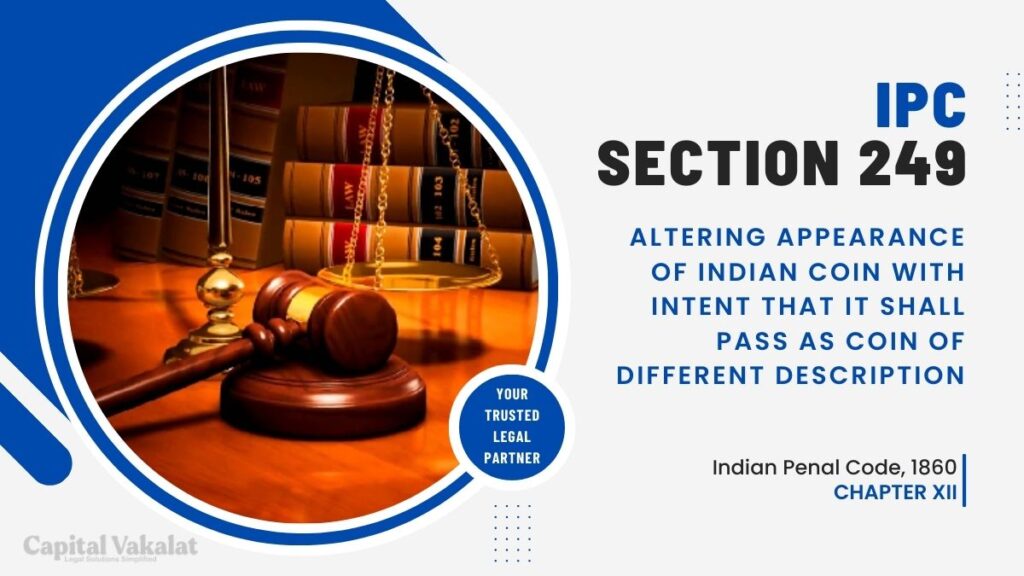Section 249 of the Indian Penal Code (IPC) addresses a unique offense that pertains to the alteration of the appearance of Indian coins with the intent that they shall pass as coins of a different description. This provision is crucial for maintaining the integrity of the currency system in India and ensuring trust in the monetary transactions of the country.

Understanding the intricacies of this law is essential, as it has far-reaching implications for both the economy and individuals involved in counterfeiting activities.
Altering the Appearance of Indian Coins
Altering the appearance of Indian coins refers to any act that changes the external characteristics of a coin to make it appear as something different. Such alterations can include filing, re-minting, or defacing coins. Individuals with malicious intent can employ various methods to modify the coins, making it challenging to detect counterfeit currency in circulation.
Intent to Pass as a Coin of Different Description
The intent behind altering the appearance of Indian coins is of paramount importance. Section 249 IPC seeks to address cases where such alterations are made with the purpose of passing the modified coin as one of a different description. In essence, this law is designed to curb the circulation of counterfeit coins that can disrupt the monetary system and harm individuals and businesses.
Historical Perspective
Counterfeiting coins is not a new concept. Throughout history, various civilizations have faced issues related to fraudulent coin production. From the Roman Empire to the medieval kingdoms, cases of coin alteration and counterfeiting have been well-documented. Understanding the historical context of this issue helps us appreciate the need for strict legal provisions like Section 249 IPC.
Section 249 IPC in Detail
The text of Section 249 IPC provides a clear definition of the offense it addresses. It states that “Whoever fraudulently…alters the appearance of any Indian coin, shall be punished with imprisonment of either description for a term which may extend to three years, and shall also be liable to fine.” This section is concise but comprehensive, making it evident that any act of altering an Indian coin is a punishable offense.
Penalties and Punishments
The penalties for offenses under Section 249 IPC are severe. Those found guilty of altering Indian coins with fraudulent intent can face imprisonment for up to three years. The imposition of fines is an additional measure to deter such activities. These strict consequences aim to safeguard the Indian currency system from counterfeit threats.
Relevance in Modern Times
In today’s digital age, one might wonder about the relevance of a law that pertains to physical currency. However, Section 249 IPC remains essential as it extends its jurisdiction to digital transactions involving cryptocurrencies. With the advent of digital currencies like Bitcoin, the law plays a crucial role in preventing digital coin counterfeiting.
Preventing Coin Alteration
Preventing coin alteration is a multifaceted task. Modern technology has introduced various security features, such as holograms, microprinting, and special inks, to deter counterfeiters. The Reserve Bank of India (RBI) continuously updates its coins to incorporate these security measures, ensuring the authenticity of Indian currency.
Notable Legal Cases
Recent legal cases involving Section 249 IPC have highlighted the significance of this provision. Notable cases include individuals attempting to pass altered coins in vending machines, retail transactions, and even online marketplaces. The outcomes of these cases emphasize the seriousness of coin alteration offenses and the legal system’s commitment to upholding the law.
Conclusion
Section 249 IPC serves as a powerful deterrent against altering the appearance of Indian coins with fraudulent intent. It safeguards the Indian currency system and upholds the trust in monetary transactions. While technology and financial systems have evolved, the relevance of this law remains unwavering, demonstrating the enduring need to protect the integrity of India’s currency. By understanding this legal provision and its implications, individuals and businesses can contribute to a secure and trustworthy monetary environment.
Frequently Asked Questions
How does Section 249 IPC relate to digital currencies?
Section 249 IPC extends its jurisdiction to digital transactions, including cryptocurrencies, to combat digital coin counterfeiting.
Are there any recent legal cases related to Section 249 IPC?
Yes, there have been recent cases involving individuals attempting to pass altered coins, which emphasize the seriousness of coin alteration offenses.
What measures can individuals take to identify altered coins?
Individuals can look for irregularities in the coin’s appearance, such as changes in weight, size, or unusual markings. If in doubt, it’s advisable to consult with a bank or a financial institution.
How can businesses protect themselves from counterfeit coins?
Businesses should employ coin verification machines and train their staff to identify altered coins. Additionally, staying updated on the latest security features introduced by the Reserve Bank of India is essential.